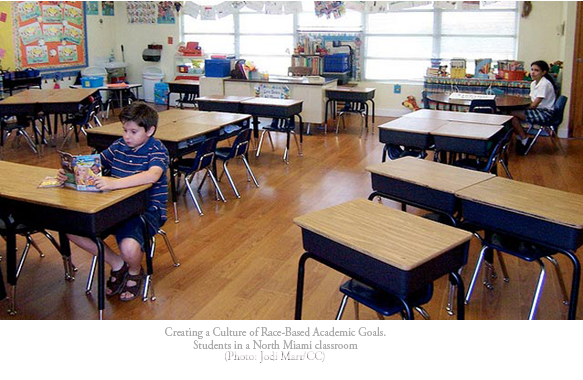Students in a North Miami classroom. (Photo: Jodi Marr/CC)
By Julianne Hing | Originally Published at Colorlines. October 16, 2012
It could have been something remarkable. Public education policy which acknowledges the reality of race and inequity? Except, Florida’s recent attempt at doing so has sparked widespread, heated criticism. Last Tuesday, the Florida State Board of Education approved an education reform plan which lays out benchmarks for student improvement based on a student’s race.
A Tampa-based CBS affiliate reported:
[B]y 2018, it wants 90 percent of Asian students, 88 percent of white students, 81 percent of Hispanics and 74 percent of black students to be reading at or above grade level. For math, the goals are 92 percent of Asian kids to be proficient, whites at 86 percent, Hispanics at 80 percent and blacks at 74 percent.The plan also calls for fewer than 80 percent of students who are English language learners, or have learning disabilities or are from economically disadvantaged families to be proficient by 2018. And since then, the wider community’s risen up in anger—some have questioned whether the plan is “racist.”
“If Asians can have a goal of 90% in reading, why can’t whites, and other subcategories? So I would just ask my fellow board members if we are happy with the signal this sends,” said board member John Padget, WTLV/WJXX TV reported. But, board member Kathleen Shanahan made her case for the plan, saying, “I think we need to be realistic in our ability to impact those at the same degree.”
And it’s true. One f the criticisms of federal education reform laws like No Child Left Behind and other accountability laws like it is that the benchmarks of student progress that school districts commit to are hopelessly unrealistic because they don’t take into consideration the extent to which social factors like a student’s home life or poverty level or the neighborhood safety impact a student’s educational opportunities. As has been well-documented, kids of color, and black, Latino students in particular, are much more likely to live in poverty, and go to schools that are poorly funded and in neighborhoods where just getting to school can be its own daily hurdle. And, as has also been well-documented, students are not immune to that kind of upheaval; that’s reflected in the achievement gap between students of color (black and Latino students in particular) and white students.
So, it might seem like one solution is to differentiate benchmarks based on a student’s race, so as to recognize the social reality of the world we live in. But the other criticism of accountability laws that mandate these linear improvements across the board—No Child Left Behind calls for all students in the U.S. to be “proficient” in math and reading by the 2013-2014 school year—is that they don’t properly acknowledge the social realities of the communities who are targeted by reforms or provide the necessary support to help schools achieve those goals. That there is in effect too much focus on punitive measures to compel school districts to improve without adequate support for helping students overcome the more basic barriers in students’ lives like poverty, joblessness, lack of access to health care and basic services. That still seems to be the missing part of the conversation, even with this very bold new policy.
In the absence of that conversation, the plan is unsettling. Besides the implementation hurdles—what of the mixed race children?—it’s a well-intentioned but ultimately misguided attempt at dealing with racialized educational inequity in U.S. schools.
Check out the State Board of Education’s strategic plan in full (PDF).












Leave A Comment